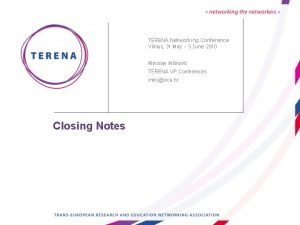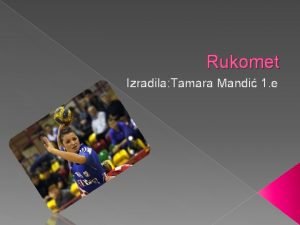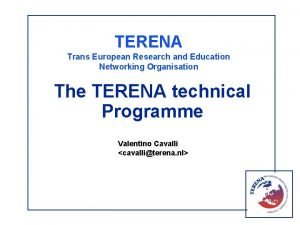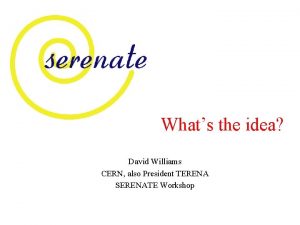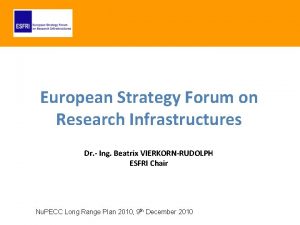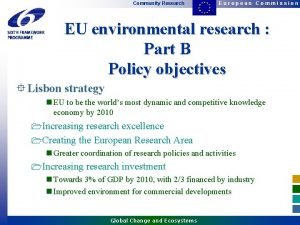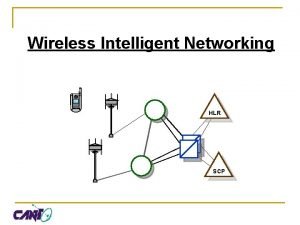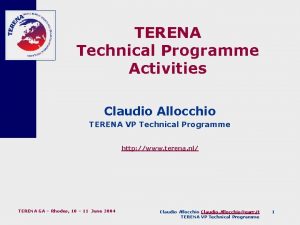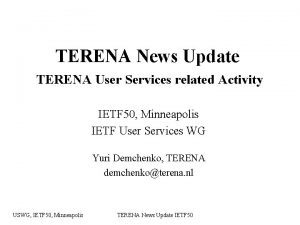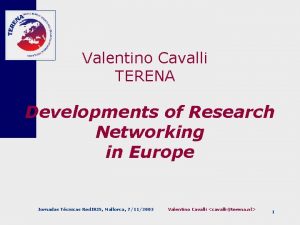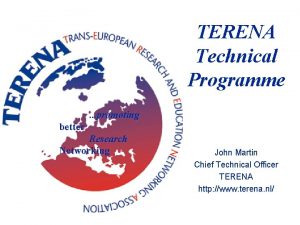European Research Networking Kevin Meynell TERENA meynellterena nl









- Slides: 9

European Research Networking Kevin Meynell, TERENA (meynell@terena. nl)

European NRNs • Approximately 40 countries in Europe + assorted international treaty organisations. • All have some form of academic/research network. • Generally three types: – Run by government department. – Run by non-governmental organisation. – ‘Private’ initiative (non-profit company, bilateral agreements or single institution lead). • Most (if not all) funded directly or indirectly by national governments. • Some additional funding from EU, NATO etc. . • Different stages of development, esp. Eastern Europe.

Pan-European Organisations • TERENA (Trans-European Research and Education Networking Association) – Formed through merger of RARE and EARN (BITNET) in 1994. – Consists of over 40 national, international and associate members. – Not-for-profit association funded mainly by subscription. • DANTE (Delivery of Advanced Networking to Europe) – Formed in 1993 as a limited non-profit company. – 15 shareholding NRNs. EU + Czech Rep, Slovenia & Poland • CEENet (Central and Eastern Europe Networking Organisation). – Loose association of Eastern European and FSU countries.

TERENA • Based in Amsterdam, Netherlands. 10 staff. • Runs Conferences and Workshops: – TERENA Networking Conference (formerly JENC) – NATO Advanced Networking Workshops • Provides legal framework for new services: – Euro. CERT – RIPE NCC • Lobbies EU and national governments + represents membership at external organisations • Technical Programme – Task Forces (TF-TANT, TF-CACHE, TF-ESME) – Projects (SCIMITAR, REIS) • Doesn’t run a network!

DANTE • Based in Cambridge, UK. 15 staff. • Established to operate pan-European Research Network. • Extremely expensive to lease cross-border lines. – EU telecommunications deregulation on 1 Jan 1999 (except Portugal and Spain) should reduce costs, but still monopolies in non-EU countries. – Would actually be cheaper to interconnect via US! • Funded 40% by European Union, remainder by fees from NRNs. – Networks planned on EU funding cycles (4 th & 5 th FP). – Current projects = QUANTUM & Q-MED. • Also have 2 x 155 Mbps to US used by smaller NRNs. • Connections to STARTAP and Japan (2 Mbps) planned.

QUANTUM & Q-MED • QUANTUM (QUALity Network Technology for User-oriented Multimedia) project funded by 5 th Call of EU Fourth Framework Programme. • 3 goals: – A pan-European network running at speeds of up to 155 Mbit/s. Known as TEN-155. – Provision of bandwidth for research purposes. – Advanced technology testing programme. • Q-MED is a complimentary project to connect Cyprus and Israel to TEN-155.

TEN-155 • Pan-European network based on ATM over STM-1 circuits. • Single provider unlike previous networks (KPN). • Managed bandwidth provides a number of services (production IP traffic, VPN for research, Mbone, native IPv 6). • ATM considered the only mechanism that is capable of fulfilling these requirements (at the moment). • Research VPN allocated 2 -15 Mbps. – – Access speed can be determined by each NRN. May be used by approved EU projects + TF-TANT Usage charging applies (in theory). Used to determine suitability of new technologies for production environment.


TF-TANT • Joint activity between TERENA and DANTE. • Works on voluntary basis. NRNs + commercial vendors. • Determines suitability of new technologies for future networks (also applicable to NRNs). • Test programme includes: – – – – MPLS (completed). Differentiated Services & RSVP (in progress). Native IPv 6 network (established). Mbone running MBGP (established). ATM SVCs with Qo. S (part of acceptance tests). Policy Servers (in progress). Traffic charging mechanisms (in progress).
